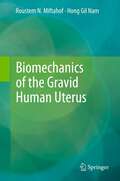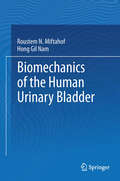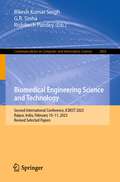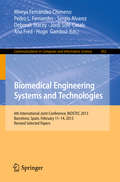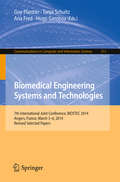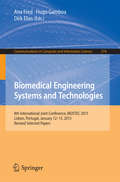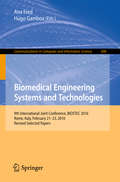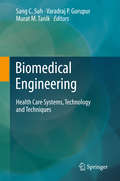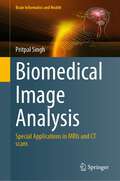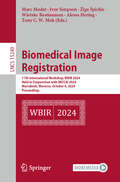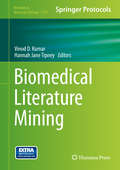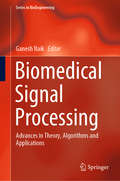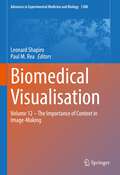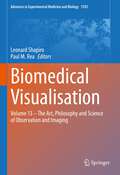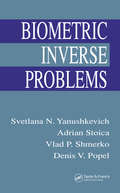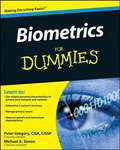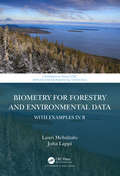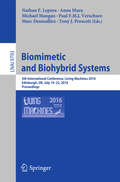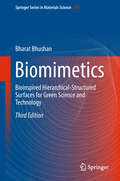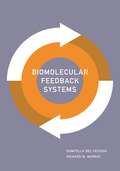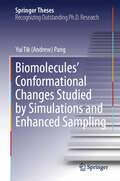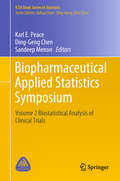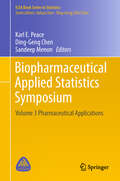- Table View
- List View
Biomechanics of the Gravid Human Uterus
by Roustem N. Miftahof Hong Gil NamThe complexity of human uterine function and regulation is one of the great wonders of nature and represents a daunting challenge to unravel. This book is dedicated to the biomechanical modeling of the gravid human uterus and gives an example of the application of the mechanics of solids and the theory of soft shells to explore medical problems of labor and delivery. After a brief overview of the anatomy, physiology and biomechanics of the uterus, the authors focus mainly on electromechanical wave processes, their origin, dynamics, and neuroendocrine and pharmacological modulations. In the last chapter applications, pitfalls and problems related to modeling and computer simulations of the pregnant uterus and pelvic floor structures are discussed. A collection of exercises is added at the end of each chapter to help readers with self-evaluation. The book serves as an invaluable source of information for researchers, instructors and advanced undergraduate and graduate students interested in systems biology, applied mathematics and biomedical engineering.
Biomechanics of the Human Urinary Bladder
by Roustem N. Miftahof Hong Gil NamAs a research subject, the biomechanics of the urinary bladder are relatively young, yet medical problems associated with them are as old as mankind. Offering an update on recent achievements in the field, the authors highlight the underlying biological, chemical and physical processes of bladder function and present the systematic development of a mathematical model of the organ as a thin, soft biological shell. The book will be a valuable resource for postgraduate students and researchers interested in the applications of computational mathematics and solid mechanics to modern problems in biomedical engineering and medicine.
Biomedical Engineering Science and Technology: Second International Conference, ICBEST 2023, Raipur, India, February 10–11, 2023, Revised Selected Papers (Communications in Computer and Information Science #2003)
by G. R. Sinha Bikesh Kumar Singh Rishikesh PandeyThis CCIS post conference volume constitutes the proceedings of the Second International Conference, ICBEST 2023, in Raipur, India, in February 2023. The 32 full papers together in this volume were carefully reviewed and selected from 60 submissions. The conference's fundamental theme was "Computing in Biomedical Research". They were organized in three tracks as follows: Artificial Intelligence in Healthcare; Computational Mechanics in Healthcare and Health Informatics.
Biomedical Engineering Systems and Technologies: 6th International Joint Conference, BIOSTEC 2013, Barcelona, Spain, February 11-14, 2013, Revised Selected Papers (Communications in Computer and Information Science #452)
by Jordi Solé-Casals Ana Fred Mireya Fernández-Chimeno Pedro L. Fernandes Sergio Alvarez Deborah Stacey Hugo GamboaThis book constitutes the thoroughly refereed post-conference proceedings of the 6th International Joint Conference on Biomedical Engineering Systems and Technologies, BIOSTEC 2013, held in Barcelona, Spain, in February 2013. The 28 revised full papers presented were carefully reviewed and selected from a total of 392 submissions. The papers cover a wide range of topics and are organized in four general topical sections on biomedical electronics and devices; bioinformatics models, methods and algorithms; bio-inspired systems and signal processing; health informatics.
Biomedical Engineering Systems and Technologies: 7th International Joint Conference, BIOSTEC 2014, Angers, France, March 3-6, 2014, Revised Selected Papers (Communications in Computer and Information Science #511)
by Ana Fred Hugo Gamboa Guy Plantier Tanja SchultzThis book constitutes the thoroughly refereed post-conference proceedings of the 7th International Joint Conference on Biomedical Engineering Systems and Technologies, BIOSTEC 2014, held in Angers, France, in March 2014. The 25 revised full papers presented were carefully reviewed and selected from a total of 362 submissions. The papers cover a wide range of topics and are organized in topical sections on biomedical electronics and devices; bioimaging; bioinformatics models, methods and algorithms; bio-inspired systems and signal processing; health informatics.
Biomedical Engineering Systems and Technologies: 8th International Joint Conference, BIOSTEC 2015, Lisbon, Portugal, January 12-15, 2015, Revised Selected Papers (Communications in Computer and Information Science #574)
by Ana Fred Hugo Gamboa Dirk EliasThis book constitutes the thoroughly refereedpost-conference proceedings of the 8th International Joint Conference onBiomedical Engineering Systems and Technologies, BIOSTEC 2015, held in Lisbon,Portugal, in January 2015. The 27 revised full papers presented together with aninvited paper were carefully reviewed and selected from a total of 375submissions. The papers cover a wide range of topics and are organized in fourgeneral topical sections on biomedical electronics and devices;bioimaging; bioinformatics models,methods and algorithms; bio-inspired systems and signalprocessing; health informatics.
Biomedical Engineering Systems and Technologies: 9th International Joint Conference, BIOSTEC 2016, Rome, Italy, February 21–23, 2016, Revised Selected Papers (Communications in Computer and Information Science #690)
by Ana Fred Hugo GamboaThis book contains the best papers of the First International Joint Conference on B- medical Engineering Systems and Technologies (BIOSTEC 2008), organized by the Institute for Systems and Technologies of Information Control and Communication (INSTICC), technically co-sponsored by the IEEE Engineering in Medicine and Bi- ogy Society (EMB), ACM SIGART and the Workflow Management Coalition (WfMC), in cooperation with AAAI. The purpose of the International Joint Conference on Biomedical Engineering S- tems and Technologies is to bring together researchers and practitioners, including engineers, biologists, health professionals and informatics/computer scientists, int- ested in both theoretical advances and applications of information systems, artificial intelligence, signal processing, electronics and other engineering tools in knowledge areas related to biology and medicine. BIOSTEC is composed of three co-located conferences; each specializes in one of the aforementioned main knowledge areas, namely: * BIODEVICES (International Conference on Biomedical Electronics and - vices) focuses on aspects related to electronics and mechanical engineering, - pecially equipment and materials inspired from biological systems and/or - dressing biological requirements. Monitoring devices, instrumentation sensors and systems, biorobotics, micro-nanotechnologies and biomaterials are some of the technologies addressed at this conference.
Biomedical Engineering: Health Care Systems, Technology and Techniques
by Sang C. Suh Varadraj Gurupur Murat M. TanikBiomedical Engineering: Health Care Systems, Technology and Techniques is an edited volume with contributions from world experts. It provides readers with unique contributions related to current research and future healthcare systems. Practitioners and researchers focused on computer science, bioinformatics, engineering and medicine will find this book a valuable reference.
Biomedical Image Analysis: Special Applications in MRIs and CT scans (Brain Informatics and Health)
by Pritpal SinghThis book provides an in-depth study of biomedical image analysis. Itreviews and summarizes previous research work in biomedical image analysis andalso provides a brief introduction to other computation techniques, such asfuzzy sets, neutrosophic sets, clustering algorithm and fast forward quantumoptimization algorithm, focusing on how these techniques can be integrated intodifferent phases of the biomedical image analysis. In particular, this bookdescribes novel methods resulting from the fuzzy sets, neutrosophic sets,clustering algorithm and fast forward quantum optimization algorithm. It alsodemonstrates how a new quantum-clustering based model can be successfullyapplied in the context of clustering the COVID-19 CT scans. Thanks to itseasy-to-read style and the clear explanations of the models, the book can beused as a concise yet comprehensive reference guide to biomedical imageanalysis, and will be valuable not only for graduate students, but also forresearchers and professionals working for academic, business and governmentinstitutes and medical colleges.
Biomedical Image Registration: 11th International Workshop, WBIR 2024, Held in Conjunction with MICCAI 2024, Marrakesh, Morocco, October 6, 2024, Proceedings (Lecture Notes in Computer Science #15249)
by Marc Modat Ivor Simpson Žiga Špiclin Alessa Hering Wietske Bastiaansen Tony C. W. MokThis book constitutes the refereed proceedings of the 11th International Workshop on Biomedical Image Registration, WBIR 2024, held in conjunction with the 27th International conference on Medical Image Computing and Computer Assisted Intervention, MICCAI 2024, in Marrakesh, Morocco in October 2024. The 28 full papers presented in this book were carefully reviewed and selected from 32 submissions. These papers have been categorized under the following topical sections: Architectures; Robustness; Atlas/ Fusion; Feature/ Similarity Learning & Efficiency.
Biomedical Informatics: Discovering Knowledge in Big Data (Lecture Notes in Computer Science #8401)
by Andreas HolzingerThis book provides a broad overview of the topic Bioinformatics with focus on data, information and knowledge. From data acquisition and storage to visualization, ranging through privacy, regulatory and other practical and theoretical topics, the author touches several fundamental aspects of the innovative interface between Medical and Technology domains that is Biomedical Informatics. Each chapter starts by providing a useful inventory of definitions and commonly used acronyms for each topic and throughout the text, the reader finds several real-world examples, methodologies and ideas that complement the technical and theoretical background This new edition includes new sections at the end of each chapter, called "future outlook and research avenues," providing pointers to future challenges. At the beginning of each chapter a new section called "key problems", has been added, where the author discusses possible traps and unsolvable or major problems
Biomedical Literature Mining (Methods in Molecular Biology #1159)
by Vinod D. Kumar Hannah Jane TipneyBiomedical Literature Mining, discusses the multiple facets of modern biomedical literature mining and its many applications in genomics and systems biology. The volume is divided into three sections focusing on information retrieval, integrated text-mining approaches and domain-specific mining methods. Written in the highly successful Methods in Molecular Biology series format, chapters include introductions to their respective topics, lists of the necessary materials and reagents, step-by-step, readily reproducible laboratory protocols and key tips on troubleshooting and avoiding known pitfalls. Authoritative and practical, Biomedical Literature Mining is designed as a useful bioinformatics resource in biomedical literature text mining for both those long experienced in or entirely new to, the field.
Biomedical Signal Processing: Advances in Theory, Algorithms and Applications (Series in BioEngineering)
by Ganesh NaikThis book reports on the latest advances in the study of biomedical signal processing, and discusses in detail a number of open problems concerning clinical, biomedical and neural signals. It methodically collects and presents in a unified form the research findings previously scattered throughout various scientific journals and conference proceedings. In addition, the chapters are self-contained and can be read independently. Accordingly, the book will be of interest to university researchers, R&D engineers and graduate students who wish to learn the core principles of biomedical signal analysis, algorithms, and applications, while also offering a valuable reference work for biomedical engineers and clinicians who wish to learn more about the theory and recent applications of neural engineering and biomedical signal processing.
Biomedical Visualisation: Volume 12 ‒ The Importance of Context in Image-Making (Advances in Experimental Medicine and Biology #1388)
by Leonard Shapiro Paul M. ReaThis image-rich book explores the practice as well as the theory of visual representation and presents us with the importance of designing appropriate images for communication to specific target audiences. This includes the appropriate choice of high-tech digital or low-tech analogue technologies in image-making for communication within the medical education, biological research and community health contexts. We hear from medical students about the value of using clay modelling in their understanding of anatomy, from educators and curriculum designers about visual affordances in medical education and from a community-driven project in South Africa about their innovative use of locally designed images and culture-specific narratives for communicating important health information to marginalised communities. A chapter explores the evolution of scientific visualisation and representation of big data to a variety of audiences, and another presents the innovative 3D construction of internal cellular structures from microscopic 2D slices. As we embrace blended learning in anatomy education, a timely chapter prompts us to think further about and contribute to the ongoing discourse around important ethical considerations in the use and sharing of digital images of body donors. This book will appeal to educators, medical illustrators, curriculum designers, post-graduate students, community health practitioners and biomedical researchers.
Biomedical Visualisation: Volume 13 – The Art, Philosophy and Science of Observation and Imaging (Advances in Experimental Medicine and Biology #1392)
by Leonard Shapiro Paul M. ReaThis book brings together current advances in high-technology visualisation and the age-old but science-adapted practice of drawing for improved observation in medical education and surgical planning and practice. We begin this book with a chapter reviewing the history of confusion around visualisation, observation and theory, outlining the implications for medical imaging. The authors consider the shifting influence of various schools of philosophy, and the changing agency of technology over time. We then follow with chapters on the practical application of visualisation and observation, including emerging imaging techniques in anatomy for teaching, research and clinical practice - innovation in the mapping of orthopaedic fractures for optimal orthopaedic surgical guidance - placental morphology and morphometry as a prerequisite for future pathological investigations - visualising the dural venous sinuses using volume tracing. Two chapters explore the use and benefit of drawing in medical education and surgical planning. It is worth noting that experienced surgeons and artists employ a common set of techniques as part of their work which involves both close observation and the development of fine motor skills and sensitive tool use.An in-depth look at police identikit construction from memory by eyewitnesses to crimes, outlines how an individual’s memory of a suspect’s facial features are rendered visible as a composite image.This book offers anatomy educators and clinicians an overview of the history and philosophy of medical observation and imaging, as well as an overview of contemporary imaging technologies for anatomy education and clinical practice. In addition, we offer anatomy educators and clinicians a detailed overview of drawing practices for the improvement of anatomical observation and surgical planning. Forensic psychologists and law enforcement personnel will not only benefit from a chapter dedicated to the construction of facial composites, but also from chapters on drawing and observation.
Biometric Inverse Problems
by Svetlana N. Yanushkevich Vlad P. Shmerko Adrian Stoica Denis V. PopelTraditional methods of biometric analysis are unable to overcome the limitations of existing approaches, mainly due to the lack of standards for input data, privacy concerns involving use and storage of actual biometric data, and unacceptable accuracy. Exploring solutions to inverse problems in biometrics transcends such limits and allows rich analysis of biometric information and systems for improved performance and testing. Although some particular inverse problems appear in the literature, until now there has been no comprehensive reference for these problems. Biometric Inverse Problems provides the first comprehensive treatment of biometric data synthesis and modeling. This groundbreaking reference comprises eight self-contained chapters that cover the principles of biometric inverse problems; basics of data structure design; new automatic synthetic signature, fingerprint, and iris design; synthetic faces and DNA; and new tools for biometrics based on Voronoi diagrams. Based on the authors' vast experience in the field, the book authoritatively examines new approaches and methodologies in both direct and inverse biometrics, providing invaluable analytical and benchmarking tools. The authors include case studies, examples, and implementation codes for practical illustration of the methods. Loaded with approximately 200 figures, 60 problems, 50 MATLAB® code fragments, and 200 examples, Biometric Inverse Problems sets the standard for innovation and authority in biometric data synthesis, modeling, and analysis.
Biometrics For Dummies
by Michael A. Simon Peter H. GregoryWhat is biometrics? Whether you're just curious about how biometrics can benefit society or you need to learn how to integrate biometrics with an existing security system in your organization, Biometrics For Dummies can help.Here's a friendly introduction to biometrics -- the science of identifying humans based on unique physical characteristics. With the government's use of biometrics -- for example, biometric passport readers -- and application of the technology for law enforcement, biometrics is growing more popular among security experts. Biometrics For Dummies explains biometric technology, explores biometrics policy and privacy issues with biometrics, and takes a look at where the science is heading. You'll discover:How pattern recognition and fingerprint recognition are usedThe many vulnerabilities of biometric systems and how to guard against themHow various countries are handling the privacy issues and what can be done to protect citizens' privacyHow a scan of the palm, veins in the hand, and sonar imagery establish identityWhat it takes to fully authenticate a signatureHow gait, speech, linguistic analysis, and other types of biometric identification come into playThe criteria for setting up an implementation planHow to use authentication, authorization, and access principlesWritten by a pair of security experts, Biometrics For Dummies gives you the basics in an easy-to-understand format that doesn't scrimp on substance. You'll get up to speed and enjoy getting there!
Biometry for Forestry and Environmental Data: With Examples in R
by Lauri MehtataloBiometry for Forestry and Environmental Data with Examples in R focuses on statistical methods that are widely applicable in forestry and environmental sciences, but it also includes material that is of wider interest. Features: · Describes the theory and applications of selected statistical methods and illustrates their use and basic concepts through examples with forestry and environmental data in R. · Rigorous but easily accessible presentation of the linear, nonlinear, generalized linear and multivariate models, and their mixed-effects counterparts. Chapters on tree size, tree taper, measurement errors, and forest experiments are also included. · Necessary statistical theory about random variables, estimation and prediction is included. The wide applicability of the linear prediction theory is emphasized. · The hands-on examples with implementations using R make it easier for non-statisticians to understand the concepts and apply the methods with their own data. Lot of additional material is available at www.biombook.org. The book is aimed at students and researchers in forestry and environmental studies, but it will also be of interest to statisticians and researchers in other fields as well.
Biomimetic and Biohybrid Systems: 5th International Conference, Living Machines 2016, Edinburgh, UK, July 19-22, 2016. Proceedings (Lecture Notes in Computer Science #9793)
by Tony J. Prescott Michael Mangan Nathan F. Lepora Anna Mura Paul F.M.J. Verschure Marc DesmulliezThis book constitutes the refereed proceedings of the second International Conference on Biomimetic and Biohybrid Systems, Living Machines 2013, held in London, UK, in July/August 2013. The 65 revised full papers presented were carefully reviewed and selected from various submissions. The papers are targeted at the intersection of research on novel live-like technologies inspired by scientific investigation of biological systems, biomimetics, and research that seeks to interface biological and artificial systems to create biohybrid systems
Biomimetics: Bioinspired Hierarchical-Structured Surfaces for Green Science and Technology (Biological and Medical Physics, Biomedical Engineering)
by Bharat BhushanThis book presents an overview of the general field of biomimetics - lessons from nature. It presents various examples of biomimetics, including roughness-induced superomniphobic surfaces which provide functionality of commercial interest. The major focus in the book is on lotus effect, rose petal effect, shark skin effect, and gecko adhesion. For each example, the book first presents characterization of an object to understand how a natural object provides functionality, followed by modeling and then fabrication of structures in the lab using nature’s route to verify one’s understanding of nature and provide guidance for development of optimum structures. Once it is understood how nature does it, examples of fabrication of optimum structures using smart materials and fabrication techniques, are presented. Examples of nature inspired objects are also presented throughout.
Biomolecular Feedback Systems
by Richard Murray Domitilla Del VecchioThis book provides an accessible introduction to the principles and tools for modeling, analyzing, and synthesizing biomolecular systems. It begins with modeling tools such as reaction-rate equations, reduced-order models, stochastic models, and specific models of important core processes. It then describes in detail the control and dynamical systems tools used to analyze these models. These include tools for analyzing stability of equilibria, limit cycles, robustness, and parameter uncertainty. Modeling and analysis techniques are then applied to design examples from both natural systems and synthetic biomolecular circuits. In addition, this comprehensive book addresses the problem of modular composition of synthetic circuits, the tools for analyzing the extent of modularity, and the design techniques for ensuring modular behavior. It also looks at design trade-offs, focusing on perturbations due to noise and competition for shared cellular resources.Featuring numerous exercises and illustrations throughout, Biomolecular Feedback Systems is the ideal textbook for advanced undergraduates and graduate students. For researchers, it can also serve as a self-contained reference on the feedback control techniques that can be applied to biomolecular systems.Provides a user-friendly introduction to essential concepts, tools, and applicationsCovers the most commonly used modeling methodsAddresses the modular design problem for biomolecular systemsUses design examples from both natural systems and synthetic circuitsSolutions manual (available only to professors at press.princeton.edu)An online illustration package is available to professors at press.princeton.edu
Biomolecules' Conformational Changes Studied by Simulations and Enhanced Sampling (Springer Theses)
by Yui Tik PangThis thesis illuminates the critical roles biomolecules, from small molecules to proteins, play in cellular functionality, particularly highlighting their conformational changes in response to environmental cues or binding events—a cornerstone concept in drug design as well as the manifestations of disease. It explores the conformational flexibility of small molecules and proteins, essential for predicting drug interactions and understanding biological processes. Through advanced molecular dynamics simulations and enhanced sampling techniques, this research offers unprecedented insights into the structural dynamics of three distinct biomolecular systems: the capsid assembly modulator AT130, the passenger domain of pertactin, and the SARS-CoV-2 spike protein. Each system represents a unique facet of biological complexity, underscoring the thesis's contribution to our understanding of biomolecular behavior across various scales. Furthermore, the thesis advances the field by updating the Force Field Toolkit for improved simulation accuracy. This work not only showcases the adaptability and importance of simulation techniques in modern biological research but also paves the way for novel therapeutic strategies by deepening our understanding of biomolecular dynamics.
Biopharmaceutical Applied Statistics Symposium: Volume 3 Pharmaceutical Applications (ICSA Book Series in Statistics)
by Ding-Geng Chen Karl E. Peace Sandeep MenonThis BASS book Series publishes selected high-quality papers reflecting recent advances in the design and biostatistical analysis of biopharmaceutical experiments – particularly biopharmaceutical clinical trials. The papers were selected from invited presentations at the Biopharmaceutical Applied Statistics Symposium (BASS), which was founded by the first Editor in 1994 and has since become the premier international conference in biopharmaceutical statistics. The primary aims of the BASS are: 1) to raise funding to support graduate students in biostatistics programs, and 2) to provide an opportunity for professionals engaged in pharmaceutical drug research and development to share insights into solving the problems they encounter.The BASS book series is initially divided into three volumes addressing: 1) Design of Clinical Trials; 2) Biostatistical Analysis of Clinical Trials; and 3) Pharmaceutical Applications. This book is the first of the 3-volume book series. The topics covered include: A Statistical Approach to Clinical Trial Simulations, Comparison of Statistical Analysis Methods Using Modeling and Simulation for Optimal Protocol Design, Adaptive Trial Design in Clinical Research, Best Practices and Recommendations for Trial Simulations in the Context of Designing Adaptive Clinical Trials, Designing and Analyzing Recurrent Event Data Trials, Bayesian Methodologies for Response-Adaptive Allocation, Addressing High Placebo Response in Neuroscience Clinical Trials, Phase I Cancer Clinical Trial Design: Single and Combination Agents, Sample Size and Power for the Mixed Linear Model, Crossover Designs in Clinical Trials, Data Monitoring: Structure for Clinical Trials and Sequential Monitoring Procedures, Design and Data Analysis for Multiregional Clinical Trials – Theory and Practice, Adaptive Group-Sequential Multi-regional Outcome Studies in Vaccines, Development and Validation of Patient-reported Outcomes, Interim Analysis of Survival Trials: Group Sequential Analyses, and Conditional Power – A Non-proportional Hazards Perspective.
Biopharmaceutical Applied Statistics Symposium: Volume 3 Pharmaceutical Applications (ICSA Book Series in Statistics)
by Ding-Geng Chen Karl E. Peace Sandeep MenonThis BASS book Series publishes selected high-quality papers reflecting recent advances in the design and biostatistical analysis of biopharmaceutical experiments – particularly biopharmaceutical clinical trials. The papers were selected from invited presentations at the Biopharmaceutical Applied Statistics Symposium (BASS), which was founded by the first Editor in 1994 and has since become the premier international conference in biopharmaceutical statistics. The primary aims of the BASS are: 1) to raise funding to support graduate students in biostatistics programs, and 2) to provide an opportunity for professionals engaged in pharmaceutical drug research and development to share insights into solving the problems they encounter.The BASS book series is initially divided into three volumes addressing: 1) Design of Clinical Trials; 2) Biostatistical Analysis of Clinical Trials; and 3) Pharmaceutical Applications. This book is the second of the 3-volume book series. The topics covered include: Statistical Approaches to the Meta-analysis of Randomized Clinical Trials, Collaborative Targeted Maximum Likelihood Estimation to Assess Causal Effects in Observational Studies, Generalized Tests in Clinical Trials, Discrete Time-to-event and Score-based Methods with Application to Composite Endpoint for Assessing Evidence of Disease Activity-Free , Imputing Missing Data Using a Surrogate Biomarker: Analyzing the Incidence of Endometrial Hyperplasia, Selected Statistical Issues in Patient-reported Outcomes, Network Meta-analysis, Detecting Safety Signals Among Adverse Events in Clinical Trials, Applied Meta-analysis Using R, Treatment of Missing Data in Comparative Effectiveness Research, Causal Estimands: A Common Language for Missing Data, Bayesian Subgroup Analysis with Examples, Statistical Methods in Diagnostic Devices, A Question-Based Approach to the Analysis of Safety Data, Analysis of Two-stage Adaptive Seamless Trial Design, and Multiplicity Problems in Clinical Trials – A Regulatory Perspective.
Biopharmaceutical Applied Statistics Symposium: Volume 3 Pharmaceutical Applications (ICSA Book Series in Statistics)
by Ding-Geng Chen Karl E. Peace Sandeep MenonThis BASS book Series publishes selected high-quality papers reflecting recent advances in the design and biostatistical analysis of biopharmaceutical experiments – particularly biopharmaceutical clinical trials. The papers were selected from invited presentations at the Biopharmaceutical Applied Statistics Symposium (BASS), which was founded by the first Editor in 1994 and has since become the premier international conference in biopharmaceutical statistics. The primary aims of the BASS are: 1) to raise funding to support graduate students in biostatistics programs, and 2) to provide an opportunity for professionals engaged in pharmaceutical drug research and development to share insights into solving the problems they encounter.The BASS book series is initially divided into three volumes addressing: 1) Design of Clinical Trials; 2) Biostatistical Analysis of Clinical Trials; and 3) Pharmaceutical Applications. This book is the third of the 3-volume book series. The topics covered include: Targeted Learning of Optimal Individualized Treatment Rules under Cost Constraints, Uses of Mixture Normal Distribution in Genomics and Otherwise, Personalized Medicine – Design Considerations, Adaptive Biomarker Subpopulation and Tumor Type Selection in Phase III Oncology Trials, High Dimensional Data in Genomics; Synergy or Additivity - The Importance of Defining the Primary Endpoint, Full Bayesian Adaptive Dose Finding Using Toxicity Probability Interval (TPI), Alpha-recycling for the Analyses of Primary and Secondary Endpoints of Clinical Trials, Expanded Interpretations of Results of Carcinogenicity Studies of Pharmaceuticals, Randomized Clinical Trials for Orphan Drug Development, Mediation Modeling in Randomized Trials with Non-normal Outcome Variables, Statistical Considerations in Using Images in Clinical Trials, Interesting Applications over 30 Years of Consulting, Uncovering Fraud, Misconduct and Other Data Quality Issues in Clinical Trials, Development and Evaluation of High Dimensional Prognostic Models, and Design and Analysis of Biosimilar Studies.
